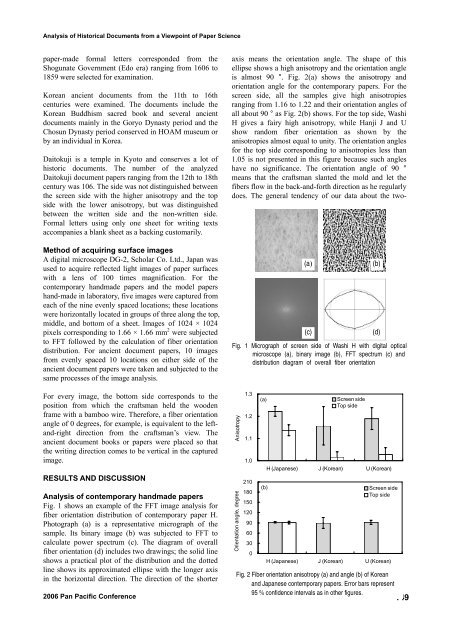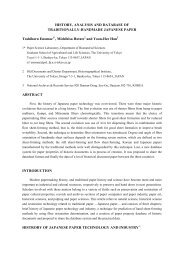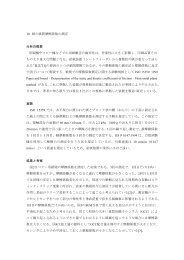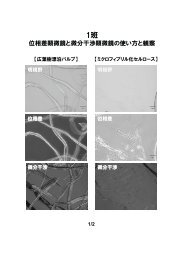Analysis of Historical Documents from a Viewpoint of Paper Science
Analysis of Historical Documents from a Viewpoint of Paper Science
Analysis of Historical Documents from a Viewpoint of Paper Science
You also want an ePaper? Increase the reach of your titles
YUMPU automatically turns print PDFs into web optimized ePapers that Google loves.
<strong>Analysis</strong> <strong>of</strong> <strong>Historical</strong> <strong>Documents</strong> <strong>from</strong> a <strong>Viewpoint</strong> <strong>of</strong> <strong>Paper</strong> <strong>Science</strong><br />
paper-made formal letters corresponded <strong>from</strong> the<br />
Shogunate Government (Edo era) ranging <strong>from</strong> 1606 to<br />
1859 were selected for examination.<br />
Korean ancient documents <strong>from</strong> the 11th to 16th<br />
centuries were examined. The documents include the<br />
Korean Buddhism sacred book and several ancient<br />
documents mainly in the Goryo Dynasty period and the<br />
Chosun Dynasty period conserved in HOAM museum or<br />
by an individual in Korea.<br />
Daitokuji is a temple in Kyoto and conserves a lot <strong>of</strong><br />
historic documents. The number <strong>of</strong> the analyzed<br />
Daitokuji document papers ranging <strong>from</strong> the 12th to 18th<br />
century was 106. The side was not distinguished between<br />
the screen side with the higher anisotropy and the top<br />
side with the lower anisotropy, but was distinguished<br />
between the written side and the non-written side.<br />
Formal letters using only one sheet for writing texts<br />
accompanies a blank sheet as a backing customarily.<br />
Method <strong>of</strong> acquiring surface images<br />
A digital microscope DG-2, Scholar Co. Ltd., Japan was<br />
used to acquire reflected light images <strong>of</strong> paper surfaces<br />
with a lens <strong>of</strong> 100 times magnification. For the<br />
contemporary handmade papers and the model papers<br />
hand-made in laboratory, five images were captured <strong>from</strong><br />
each <strong>of</strong> the nine evenly spaced locations; these locations<br />
were horizontally located in groups <strong>of</strong> three along the top,<br />
middle, and bottom <strong>of</strong> a sheet. Images <strong>of</strong> 1024 × 1024<br />
pixels corresponding to 1.66 × 1.66 mm 2 were subjected<br />
to FFT followed by the calculation <strong>of</strong> fiber orientation<br />
distribution. For ancient document papers, 10 images<br />
<strong>from</strong> evenly spaced 10 locations on either side <strong>of</strong> the<br />
ancient document papers were taken and subjected to the<br />
same processes <strong>of</strong> the image analysis.<br />
axis means the orientation angle. The shape <strong>of</strong> this<br />
ellipse shows a high anisotropy and the orientation angle<br />
is almost 90 °. Fig. 2(a) shows the anisotropy and<br />
orientation angle for the contemporary papers. For the<br />
screen side, all the samples give high anisotropies<br />
ranging <strong>from</strong> 1.16 to 1.22 and their orientation angles <strong>of</strong><br />
all about 90 ° as Fig. 2(b) shows. For the top side, Washi<br />
H gives a fairy high anisotropy, while Hanji J and U<br />
show random fiber orientation as shown by the<br />
anisotropies almost equal to unity. The orientation angles<br />
for the top side corresponding to anisotropies less than<br />
1.05 is not presented in this figure because such angles<br />
have no significance. The orientation angle <strong>of</strong> 90 °<br />
means that the craftsman slanted the mold and let the<br />
fibers flow in the back-and-forth direction as he regularly<br />
does. The general tendency <strong>of</strong> our data about the two-<br />
(a)<br />
(c)<br />
Fig. 1 Micrograph <strong>of</strong> screen side <strong>of</strong> Washi H with digital optical<br />
microscope (a), binary image (b), FFT spectrum (c) and<br />
distribution diagram <strong>of</strong> overall fiber orientation<br />
(b)<br />
(d)<br />
For every image, the bottom side corresponds to the<br />
position <strong>from</strong> which the craftsman held the wooden<br />
frame with a bamboo wire. Therefore, a fiber orientation<br />
angle <strong>of</strong> 0 degrees, for example, is equivalent to the leftand-right<br />
direction <strong>from</strong> the craftsman’s view. The<br />
ancient document books or papers were placed so that<br />
the writing direction comes to be vertical in the captured<br />
image.<br />
RESULTS AND DISCUSSION<br />
<strong>Analysis</strong> <strong>of</strong> contemporary handmade papers<br />
Fig. 1 shows an example <strong>of</strong> the FFT image analysis for<br />
fiber orientation distribution <strong>of</strong> contemporary paper H.<br />
Photograph (a) is a representative micrograph <strong>of</strong> the<br />
sample. Its binary image (b) was subjected to FFT to<br />
calculate power spectrum (c). The diagram <strong>of</strong> overall<br />
fiber orientation (d) includes two drawings; the solid line<br />
shows a practical plot <strong>of</strong> the distribution and the dotted<br />
line shows its approximated ellipse with the longer axis<br />
in the horizontal direction. The direction <strong>of</strong> the shorter<br />
Anisotropy<br />
Orientation angle, degree<br />
1.3<br />
1.2<br />
1.1<br />
1.0<br />
210<br />
180<br />
150<br />
120<br />
90<br />
60<br />
30<br />
0<br />
(a)<br />
(b)<br />
Screen side<br />
Top side<br />
H (Japanese) J (Korean) U (Korean)<br />
Screen side<br />
Top side<br />
H (Japanese) J (Korean) U (Korean)<br />
Fig. 2 Fiber orientation anisotropy (a) and angle (b) <strong>of</strong> Korean<br />
and Japanese contemporary papers. Error bars represent<br />
95 % confidence intervals as in other figures.<br />
2006 Pan Pacific Conference 149

















